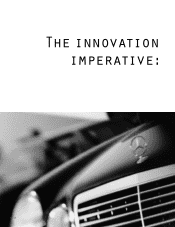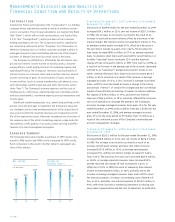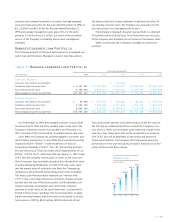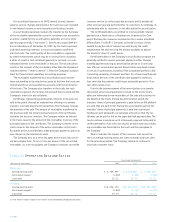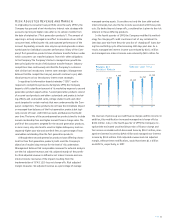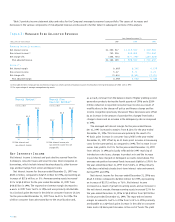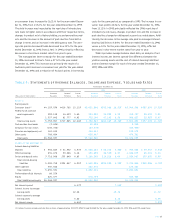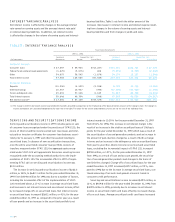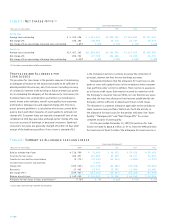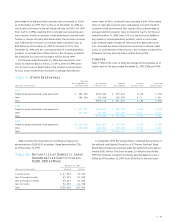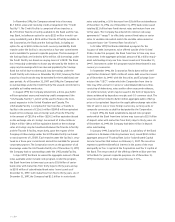Capital One 1997 Annual Report Download - page 22
Download and view the complete annual report
Please find page 22 of the 1997 Capital One annual report below. You can navigate through the pages in the report by either clicking on the pages listed below, or by using the keyword search tool below to find specific information within the annual report.
PAGE 20
For securitized loans prior to 1997, interest income, interest
expense, service charges and provision for loan losses are included
in non-interest income as servicing and securitizations income.
A securitization generally involves the transfer by the Company
of the receivables generated by a pool of consumer loan accounts to
an entity created for the securitization, generally a trust or other
special purpose entity (“the trusts”). Certificates issued ($9.4 bil-
lion outstanding as of December 31, 1997) by the trusts represent
undivided ownership interests in those receivables transferred
into the trusts.The credit quality of the receivables is supported
by credit enhancement, which may be in various forms including
a letter of credit, a cash collateral guaranty or account, or a sub-
ordinated interest in the receivables in the pool.The securitization
results in the removal of the receivables, other than the Company’s
retained interest (“seller’s interest”), from the Company’s balance
sheet for financial and regulatory accounting purposes.
The receivables transferred to a securitization pool include
those outstanding in the selected accounts at the time the trusts are
formed and those arising under the accounts until the termination
of the trusts.The Company also transfers to the trusts the cash
collected in payment of principal, interest and fees received and the
Company’s interest in any collateral.
Certificates representing participation interests in the pool are
sold to the public through an underwritten offering or to private
investors in private placement transactions.The Company receives
the proceeds of the sale.The amount of receivables transferred to
the trusts exceeds the initial principal amount of the certificates
issued by the trusts to investors.The Company retains an interest
in the trusts equal to the amount of the receivables in excess of the
principal balance of the certificates.The Company’s interest in the
trusts varies as the amount of the excess receivables in the trusts
fluctuates as the accountholders make principal payments and incur
new charges on the selected accounts.
The Company acts as a servicing agent and receives loan servic-
ing fees ranging from .75% to 2.0% per annum of the securitized
receivables. As a servicing agent, the Company continues to provide
customer service, to collect past-due accounts and to provide all
other services typically performed for its customers. Accordingly, its
relationship with its customers is not affected by the securitization.
The certificateholders are entitled to receive periodic interest
payments at a fixed rate or a floating rate. In general, the Com-
pany’s floating rate issuances are based on the London InterBank
Offered Rate (“LIBOR”). Amounts collected in excess of that
needed to pay the rate of interest are used to pay the credit
enhancement fee and servicing fee and are available to absorb
the investors’ share of credit losses.
Certificateholders in the Company’s securitization program are
generally entitled to receive principal payments either through
monthly payments during an amortization period or in one lump
sum after an accumulation period. Amortization may begin sooner
in certain circumstances, including if the annualized portfolio yield
(consisting, generally, of interest and fees) for a three-month period
drops below the sum of the certificate rate payable to investors,
loan servicing fees and net credit losses during the period or if cer-
tain other events occur.
Prior to the commencement of the amortization or accumula-
tion period, all principal payments received on the trusts’ receiv-
ables are reinvested in new receivables of the selected accounts for
the benefit of the trusts. During the amortization period, the
investors’ share of principal payments is paid to the certificatehold-
ers until they are paid in full. During the accumulation period, the
investors’ share of principal payments is paid into a principal
funding account designed to accumulate amounts so that the cer-
tificates can be paid in full on the expected final payment date.The
trusts continue in existence until all amounts required to be paid to
certificateholders of all series are repaid, at which time any remain-
ing receivables and funds held in the trusts will be reassigned to
the Company.
Table 2 indicates the impact of the consumer loan securitiza-
tions on average earning assets, net interest margin and loan yield
for the periods presented.The Company intends to continue to
securitize consumer loans.
Table 2: Operating Data and Ratios
Year Ended December 31
(Dollars in Thousands) 1997 1996 1995
Reported:
Average earning assets $ 5,753,997 $ 4,798,987 $ 3,902,832
Net interest margin(1) 6.66% 7.62% 5.33%
Loan yield 15.11 16.21 13.52
Managed:
Average earning assets $14,658,143 $12,415,540 $10,051,902
Net interest margin(1) 8.86% 8.16% 6.27%
Loan yield 15.73 14.76 13.12
(1) Net interest margin is equal to net interest income divided by average earning assets.


